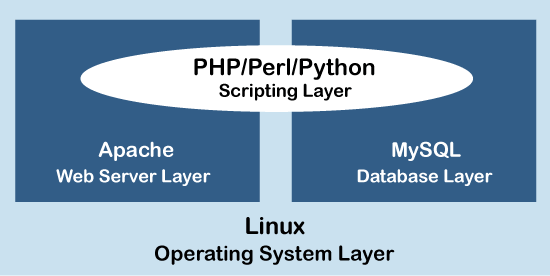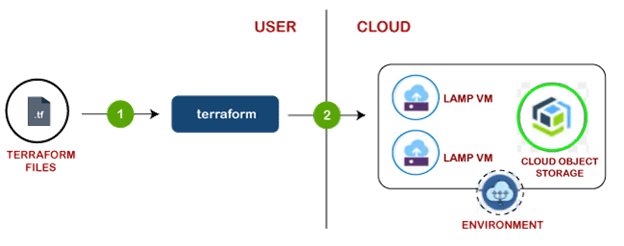What is LAMP?
LAMP is an open-source Web development platform that uses Linux as the operating system, Apache as the Web server, MySQL as the relational database management system and PHP/Perl/Python as the object-oriented scripting language.
Sometimes LAMP is referred to as a LAMP stack because the platform has four layers. Stacks can be built on different operating systems.
LAMP is a example of a web service stack, named as an acronym. The LAMP components are largely interchangeable and not limited to the original selection. LAMP is suitable for building dynamic web sites and web applications.
Since its creation, the LAMP model has been adapted to another component, though typically consisting of free and open-source software.
Developers that use these tools with a Windows operating system instead of Linux are said to be using WAMP, with a Macintosh system MAMP, and with a Solaris system SAMP.
Linux, Apache, MySQL and PHP, all of them add something unique to the development of high-performance web applications. Originally popularized from the phrase Linux, Apache, MySQL, and PHP, the acronym LAMP now refers to a generic software stack model.

The modularity of a LAMP stack may vary. Still, this particular software combination has become popular because it is sufficient to host a wide variety of website frameworks, such as Joomla, Drupal, and WordPress.
The components of the LAMP stack are present in the software repositories of the most Linux distributions. The LAMP bundle can be combined with many other free and open-source software packages, such as the following:
- netsniff-ng for security testing and hardening
- intrusion prevention (IPS) system and Snort an intrusion detection (IDS)
- RRD tool for diagrams
- Nagios, Cacti, or Collectd for monitoring
LAMP Stack Components
Linux based web servers consist of four software components. These components are arranged in layers supporting one another and make up the software stack. Websites and Web Applications run on top of this underlying stack. The common software components are as follows:
- Linux: Linux started in 1991. It sets the foundation for the stack model. All other layers are run on top of this layer.
It is an open-source and free operating system. It is endured partly because it’s flexible, and other operating systems are harder to configure. - Apache: The second layer consists of web server software, typically Apache Web Server. This layer resides on top of the Linux layer.
Apache HTTP Server is a free web server software package made available under an open-source license. It used to be known as Apache Web Server when it was created in 1995.
It offers a secure and extendable Web server that’s in sync with current HTTP standards. Web servers are responsible for translating from web browsers to their correct website. - MySQL: MySQL is a relational database management system used to store application data. It is an open-source and keeps all the data in a format that can easily be queried with the SQL language.
SQL works great with well-structured business domains, and a great workhorse that can handle even the most extensive and most complicated websites with ease.
MySQL stores details that can be queried by scripting to construct a website. MySQL usually sits on top of the Linux layer alongside Apache. In high-end configurations, MySQL can be offloaded to a separate host server. - PHP: The scripting layer consists of PHP and other similar web programming languages.
The PHP open-source scripting language works with Apache to create dynamic web pages. We cannot use HTML to perform dynamic processes such as pulling data out of a database.
To provide this type of functionality, we drop PHP code into the parts of a page that you want to be dynamic. Websites and Web Applications run within this layer.
PHP is designed for efficiency. It makes programming easier and allowing to write new code, hit refresh, and immediately see the resulting changes without the need for compiling.
LAMP Architecture
LAMP has classic layered architecture, with Linux at the lowest level. The next layer is Apache and MySQL, followed by PHP.
Although PHP is at the top or presentation layer, the PHP component sits inside Apache.

The LAMP stack order of execution shows how the elements interoperate. The process starts when the Apache webserver receives requests for web pages from a user’s browser. If the request is for a PHP file, Apache passes the request to PHP, which loads the file and executes the code contained in the file. PHP also communicates with MySQL to fetch any data referenced in the code.
PHP then uses the code in the file and the data from the database to create the HTML that browsers require to display web pages. The LAMP stack is efficient at handling not only static web pages but also dynamic pages where the content may change each time it is loaded depending on the date, time, user identity and other factors.
After running the file code, PHP then passes the resulting data back to the Apache webserver to send to the browser. It can also store this new data in MySQL. And of course, all of these operations are enabled by the Linux operating system running at the base of the stack.
Flexibility
Although LAMP uses Linux as the OS, we can use the other components with an alternative OS to meet specific needs. For example, there is a WAMP stack, which uses Microsoft Windows.
LAMP is open source and non-proprietary so we can avoid lock-in. We have the flexibility to select the right components for specific projects or business requirements.
LAMP offers flexibility in other ways as well. Apache is modular in design, and we will find there are existing, customizable modules available for many different extensions. These modules range from support for other languages to authentication capabilities.
Another advantage of LAMP is its secure architecture and well-established encryption practices that have been proven in the enterprise.
Efficiency
LAMP can help to reduce development time because it is an open-source stack that has been available for more than a decade.
We can build on what other people have done in the past and make it own. Work within an Apache module that gets 80% of the way there customize the last 20%, and save considerable time as a result.
Advantages of LAMP
LAMP has the following advantages, such as:
- The LAMP stack consists of four components, all of which are examples of Free and Open-Source Software (FOSS). As they are free and available for download, it attracts the attention of many users who wish to avoid paying large sums of money when developing their website.
- Because it is FOSS, the source code of the software is shared and available for people to make changes and improvements, enhancing its overall performance.
- The LAMP stack has proven to be a secure and stable platform thanks to its vast community that contributes when any problems arise.
- We can easily customize the stack and interchange the components with other open-source software to suit the needs.
LAMP Stack Alternatives
There are several variants of the four stack model as well. These variants use alternative software, replacing one or more of the standard components.
Open-source alternatives are:
- LEMP(Linux, NGINX, MySQL/MariaDB, PHP/Perl/Python)
- LAPP(Linux, Apache, PostgreSQL, PHP)
- LEAP(Linux, Eucalyptus, AppScale, Python)
- LLMP(Linux, Lighttpd, MySQL/MariaDB, PHP/Perl/Python)
While non-open source alternatives include:
- WAMP(Windows, Apache, MySQL/MariaDB, PHP/Perl/Python)
- WIMP(Windows, Internet Information Services, MySQL/MariaDB, PHP/Perl/Python)
- MAMP(Mac OS x, Apache, MySQL/MariaDB, PHP/Perl/Python)
